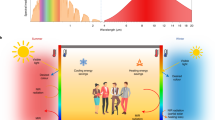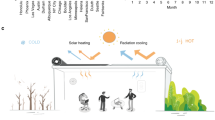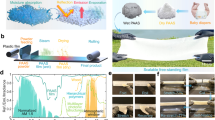Abstract
Radiative thermoregulation can reduce the energy consumption for heating, ventilation and air-conditioning (HVAC) in buildings, and therefore contribute substantially to climate change mitigation. Electrochromism, a phenomenon in which a material exhibits reversible colour changes under an external electrical stimulus, can help control the heat balance of buildings in response to fluctuating weather conditions; however, its implementation has been largely limited to visible and near-infrared wavelength regimes. Here we develop an aqueous flexible electrochromic design for use as a building envelop based on graphene ultra-wideband transparent conductive electrode and reversible copper electrodeposition, in which the thermal emissivity can be tailored to vary between 0.07 and 0.92 with excellent long-term durability. Building energy simulations show that our design as building envelopes can save on year-round operational HVAC energy consumption across the United States by up to 43.1 MBtu on average in specific zones. Such dynamic emissivity tunability can further serve as a non-destructive technological solution to retrofit poorly insulated or historic buildings. Our work suggests a feasible pathway to radiative thermoregulation for more energy-efficient HVAC and solving some of the global climate change issues.
This is a preview of subscription content, access via your institution
Access options
Access Nature and 54 other Nature Portfolio journals
Get Nature+, our best-value online-access subscription
$29.99 / 30 days
cancel any time
Subscribe to this journal
Receive 12 digital issues and online access to articles
$119.00 per year
only $9.92 per issue
Buy this article
- Purchase on Springer Link
- Instant access to full article PDF
Prices may be subject to local taxes which are calculated during checkout




Similar content being viewed by others
Data availability
All data needed to support the conclusions in the paper are present in the manuscript and/or Supplementary Information. Additional data related to this paper may be requested from the corresponding authors.
Code availability
Codes for DFT simulation are available on GitHub at https://github.com/kianpu34593/asebasic. Custom codes in Matlab and Python used for EMT calculation, building energy saving simulation and postprocessing are available upon written request from the corresponding authors.
References
Kammen, D. M. & Sunter, D. A. City-integrated renewable energy for urban sustainability. Science 352, 922–928 (2016).
Li, T. et al. A radiative cooling structural material. Science 364, 760–763 (2019).
Rogelj, J. et al. Energy system transformations for limiting end-of-century warming to below 1.5 °C. Nat. Clim. Change 5, 519–527 (2015).
Heating and Cooling (Department of Energy, 2013).
Li, X. et al. Integration of daytime radiative cooling and solar heating for year-round energy saving in buildings. Nat. Commun. 11, 6101 (2020).
Zhou, L. et al. A polydimethylsiloxane-coated metal structure for all-day radiative cooling. Nat. Sustain. 2, 718–724 (2019).
Raman, A. P., Anoma, M. A., Zhu, L., Rephaeli, E. & Fan, S. Passive radiative cooling below ambient air temperature under direct sunlight. Nature 515, 540–544 (2014).
Hsu, P.-C. et al. Radiative human body cooling by nanoporous polyethylene textile. Science 353, 1019–1023 (2016).
Jelle, B. P., Kalnæs, S. E. & Gao, T. Low-emissivity materials for building applications: a state-of-the-art review and future research perspectives. Energy Build. 96, 329–356 (2015).
Peng, Y. et al. Coloured low-emissivity films for building envelopes for year-round energy savings. Nat. Sustain. 5, 339–347 (2022).
Sherwood, S. C. Adapting to the challenges of warming. Science 370, 782–783 (2020).
Li, X., Xie, W., Sui, C. & Hsu, P.-C. Multispectral thermal management designs for net-zero energy buildings. ACS Mater. Lett. 2, 1624–1643 (2020).
Wang, S. et al. Thermochromic smart windows with highly regulated radiative cooling and solar transmission. Nano Energy 89, 106440 (2021).
Wang, S. et al. Scalable thermochromic smart windows with passive radiative cooling regulation. Science 374, 1501–1504 (2021).
Tang, K. et al. Temperature-adaptive radiative coating for all-season household thermal regulation. Science 374, 1504–1509 (2021).
Lin, C. et al. All-weather thermochromic windows for synchronous solar and thermal radiation regulation. Sci. Adv. 8, eabn7359 (2022).
Zhao, H., Sun, Q., Zhou, J., Deng, X. & Cui, J. Switchable cavitation in silicone coatings for energy-saving cooling and heating. Adv. Mater. 32, 2000870 (2020).
Mandal, J. et al. Porous polymers with switchable optical transmittance for optical and thermal regulation. Joule 3, 3088–3099 (2019).
Li, M., Liu, D., Cheng, H., Peng, L. & Zu, M. Manipulating metals for adaptive thermal camouflage. Sci. Adv. 6, eaba3494 (2020).
Araki, S., Nakamura, K., Kobayashi, K., Tsuboi, A. & Kobayashi, N. Electrochemical optical-modulation device with reversible transformation between transparent, mirror, and black. Adv. Mater. 24, OP122–OP126 (2012).
Cai, G. et al. Molecular level assembly for high-performance flexible electrochromic energy-storage devices. ACS Energy Lett. 5, 1159–1166 (2020).
Chandrasekhar, P. et al. Variable-emittance infrared electrochromic skins combining unique conducting polymers, ionic liquid electrolytes, microporous polymer membranes, and semiconductor/polymer coatings, for spacecraft thermal control. J. Appl. Polym. Sci. https://doi.org/10.1002/app.40850 (2014).
Eh, A. L.-S., Chen, J., Zhou, X., Ciou, J.-H. & Lee, P. S. Robust trioptical-state electrochromic energy storage device enabled by reversible metal electrodeposition. ACS Energy Lett. 6, 4328–4335 (2021).
Hernandez, T. S. et al. Electrolyte for improved durability of dynamic windows based on reversible metal electrodeposition. Joule 4, 1501–1513 (2020).
Li, M., Liu, D., Cheng, H., Peng, L. & Zu, M. Graphene-based reversible metal electrodeposition for dynamic infrared modulation. J. Mater. Chem. C 8, 8538–8545 (2020).
Rao, Y. et al. Ultra-wideband transparent conductive electrode for electrochromic synergistic solar and radiative heat management. ACS Energy Lett. 6, 3906–3915 (2021).
Salihoglu, O. et al. Graphene-based adaptive thermal camouflage. Nano Lett. 18, 4541–4548 (2018).
Strand, M. T. et al. Polymer inhibitors enable >900 cm2 dynamic windows based on reversible metal electrodeposition with high solar modulation. Nat. Energy 6, 546–554 (2021).
Ergoktas, M. S. et al. Multispectral graphene-based electro-optical surfaces with reversible tunability from visible to microwave wavelengths. Nat. Photon. 15, 493–498 (2021).
Baechler, M. C. et al. Building America Best Practices Series: Volume 7.1: Guide to Determining Climate Regions by County (Pacific Northwest National Laboratory, 2010).
Young, J. A. Dimethyl sulfoxide. J. Chem. Educ. 85, 629 (2008).
Tao, X. et al. A bistable variable infrared emissivity device based on reversible silver electrodeposition. Adv. Funct. Mater. 32, 2202661 (2022).
Reyna, J. et al. U.S. Building Stock Characterization Study: A National Typology for Decarbonizing U.S. Buildings. Part 1: Residential Buildings (National Renewable Energy Laboratory, 2021).
Moulder, J. F., Stickle, W. F., Sobol, P. E. & Bomben, K. D. Handbook of X-ray Photoelectron Spectroscopy (Perkin-Elmer, 1992).
Usman, M. S., Ibrahim, N. A., Shameli, K., Zainuddin, N. & Yunus, W. M. Z. W. Copper nanoparticles mediated by chitosan: synthesis and characterization via chemical methods. Molecules 17, 14928–14936 (2012).
Eslami, M., Golestani-fard, F., Saghafian, H. & Robin, A. Study on tribological behavior of electrodeposited Cu–Si3N4 composite coatings. Mater. Des. 58, 557–569 (2014).
Cai, W. & Shalaev, V. in Optical Metamaterials 11–37 (Springer, 2010).
Kats, M. A., Blanchard, R., Genevet, P. & Capasso, F. Nanometre optical coatings based on strong interference effects in highly absorbing media. Nat. Mater. 12, 20–24 (2013).
Born, M. & Wolf, E. Principles of Optics: Electromagnetic Theory of Propagation, Interference and Diffraction of Light (Elsevier, 2013).
Jäckle, M. & Groß, A. Microscopic properties of lithium, sodium, and magnesium battery anode materials related to possible dendrite growth. J. Chem. Phys. 141, 174710 (2014).
Pande, V. & Viswanathan, V. Computational screening of current collectors for enabling anode-free lithium metal batteries. ACS Energy Lett. 4, 2952–2959 (2019).
Wang, X., Tabakman, M. S. & Dai, H. Atomic layer deposition of metal oxides on pristine and functionalized graphene. J. Am. Chem. Soc. 130, 8152–8153 (2008).
Kunič, R. Carbon footprint of thermal insulation materials in building envelopes. Energy Effic. 10, 1511–1528 (2017).
Tártaro, A. S., Mata, T. M., Martins, A. A. & Esteves da Silva, J. C. G. Carbon footprint of the insulation cork board. J. Clean. Prod. 143, 925–932 (2017).
Pal, S. K., Takano, A., Alanne, K. & Siren, K. A life cycle approach to optimizing carbon footprint and costs of a residential building. Build. Environ. 123, 146–162 (2017).
Posani, M., Veiga, R. & de Freitas, V. P. Retrofitting historic walls: feasibility of thermal insulation and suitability of thermal mortars. Heritage 4, 2009–2022 (2021).
Perdew, J. P., Burke, K. & Ernzerhof, M. Generalized gradient approximation made simple. Phys. Rev. Lett. 77, 3865 (1996).
Mortensen, J. J., Hansen, L. B. & Jacobsen, K. W. Real-space grid implementation of the projector augmented wave method. Phys. Rev. B 71, 035109 (2005).
Enkovaara, J. et al. Electronic structure calculations with GPAW: a real-space implementation of the projector augmented-wave method. J. Phys. Condens. Matter 22, 253202 (2010).
Acknowledgements
We thank M. D. McGehee and A. L. Yeang (University of Colorado, Boulder, Department of Chemical and Biological Engineering) for the valuable discussion regarding electrodeposition and electrolyte synthesis, G. Tan (Zhejiang University) for kindly helping with the building energy saving calculation, and D. Wang (University of Chicago, Department of Chemistry) for helping with EDX mapping. The project was sponsored by the Collaboration Grants for Climate Change from Nicholas Institute for Energy, Environment & Sustainability and the startup fund by Pratt School of Engineering at Duke University.
Author information
Authors and Affiliations
Contributions
P.-C.H. and C.S. conceived the idea. C.S. performed all the experiments, optical fitting, building energy simulation and corresponding data analyses. T.-H.C. helped with the heat transfer measurement. V.V. and J.P. performed the DFT calculation. Y.-T.L., Y.R. and J.L. helped with the transparent electrode fabrication. X.L. helped with the energy saving calculation. Y.H. helped with the SEM and EDX mapping. R.W. and K.W. helped with the hydrophobic treatment and mid-IR transparent pigment spray-coating experiments. C.S., J.P. and P.-C.H. wrote the manuscript with input from all co-authors.
Corresponding authors
Ethics declarations
Competing interests
P.-C.H., C.S. and Y.R. have a 2021 US patent application (63/256,136). The other authors declare no competing interests.
Peer review
Peer review information
Nature Sustainability thanks Yi Long, Junqiao Wu and the other, anonymous, reviewer(s) for their contribution to the peer review of this work.
Additional information
Publisher’s note Springer Nature remains neutral with regard to jurisdictional claims in published maps and institutional affiliations.
Supplementary information
Supplementary Information
Supplementary Figs. 1–34, Discussion, Notes and Tables 1–6.
Rights and permissions
Springer Nature or its licensor (e.g. a society or other partner) holds exclusive rights to this article under a publishing agreement with the author(s) or other rightsholder(s); author self-archiving of the accepted manuscript version of this article is solely governed by the terms of such publishing agreement and applicable law.
About this article
Cite this article
Sui, C., Pu, J., Chen, TH. et al. Dynamic electrochromism for all-season radiative thermoregulation. Nat Sustain 6, 428–437 (2023). https://doi.org/10.1038/s41893-022-01023-2
Received:
Accepted:
Published:
Issue Date:
DOI: https://doi.org/10.1038/s41893-022-01023-2
This article is cited by
-
Complementary multicolor electrochromic devices with excellent stability based on porous tin oxide nanosheet scaffold
Nano Research (2024)
-
Atmospheric-moisture-induced polyacrylate hydrogels for hybrid passive cooling
Nature Communications (2023)
-
A smart way to wrap a building
Nature Sustainability (2023)



